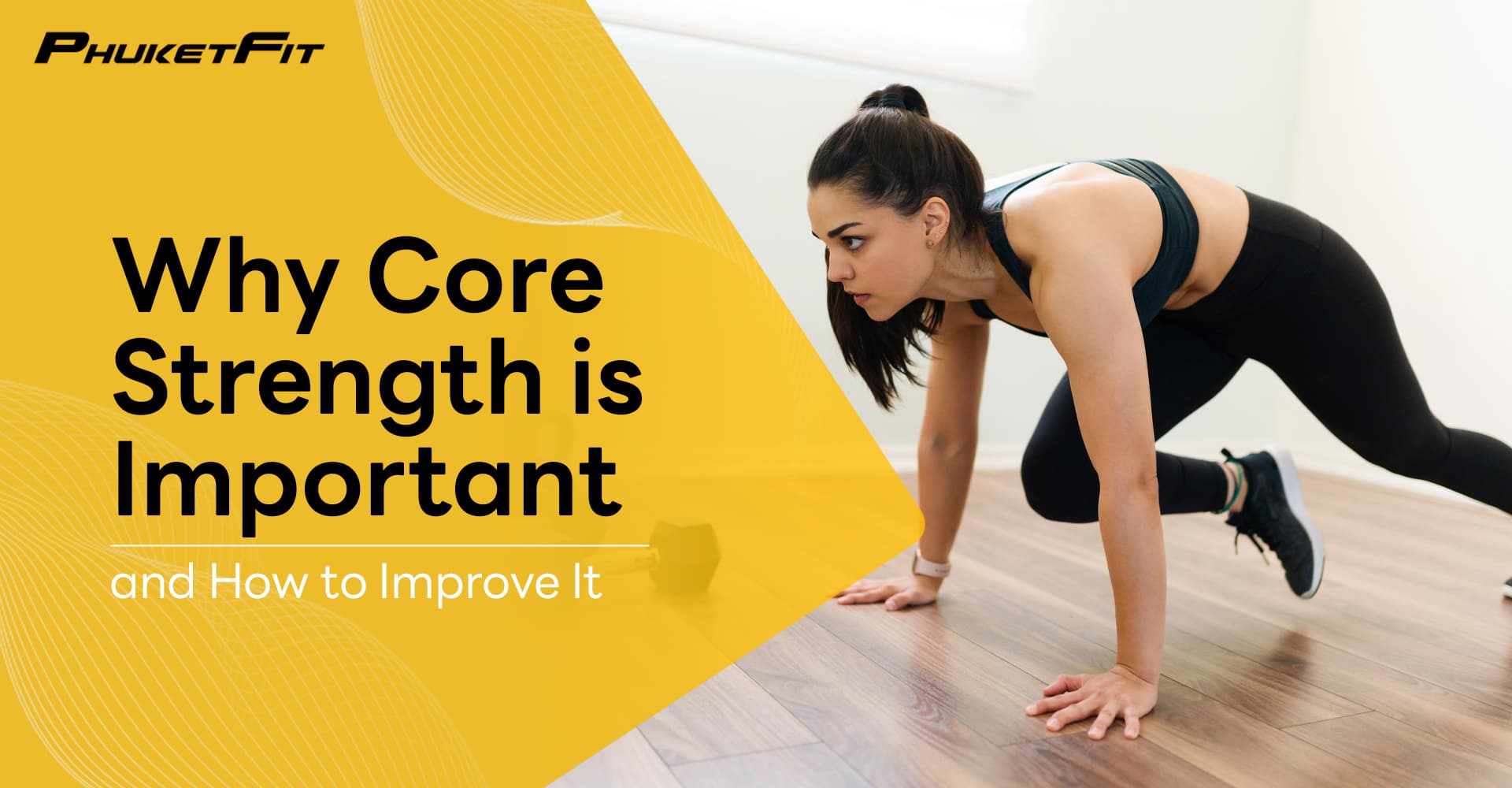
Why Core Strength is Important and How to Improve It
Imagine your body as a sturdy tree, where the trunk is your core, essential for stability and strength. Without a strong core, everything from daily tasks to athletic performance can be compromised. But what exactly encompasses this vital aspect of our physical well-being?
In this guide, we will delve into the significance of core strength, unpack its benefits, and provide practical tips and exercises to enhance it. Join us as we map out the pathways to a stronger, more resilient core, setting the foundation for improved health and performance.
The Importance of Core Strength
Having a strong core does more than make you look good. It’s crucial for your overall health and helps in everything from maintaining a straight posture to excelling in sports. Your core links your upper and lower body, making your movements more efficient and stable.
Benefits of a Strong Core
- Prevents Injuries: It supports your back and reduces the risk of back pain by taking the load off your spine.
- Improves Balance: This makes you less likely to fall and get hurt.
- Makes Daily Activities Easier: Things like bending, lifting, and twisting become much simpler.
- Boosts Athletic Performance: You can move more powerfully and tire less quickly.
What’s Included in Your Core?
It’s not just about the abs. Your core includes muscles around your midsection and back, like the six-pack abs, muscles wrapping your spine, and those near your hips. Weak core muscles can lead to slouching, back pain, and difficulty in everyday movements.
Core Strength in Daily Life
Strong core muscles are essential for almost every movement. They keep you stable, make movements easier, and reduce injury risk. A strong core also promotes better posture, especially important if you sit a lot during the day.
Benefits of Core Strength Training
Core strength training offers a lot of benefits that extend beyond the gym and into daily life. Engaging in regular core training can help you build a foundation for overall health and well-being. A stronger core assists in improving balance, stability, and body alignment, which facilitates functional movements and athletic activities. It also plays a significant role in injury prevention and management. By developing strong core muscles, you enhance your body’s natural support system, leading to improved performance and reduced risk of pain or injury.
Core strength does a lot more than just shape your body. It plays a huge role in keeping your posture straight and your spine happy. The muscles around your middle, like your abs, lower back, and those near your hips, help keep your spine in its natural shape. This means you’re less likely to slouch and feel back strain, making you look and feel better.
Why Strong Core = Better Posture
- Supports Your Spine: Strong core muscles hold up your spine well, which means you can stand taller and sit straighter.
- Helps Your Health: Good posture isn’t just about looking confident; it helps your digestion and breathing too.
Boosts Athletic Skills
If you love sports or staying active, a strong core is your best friend. It’s key for almost every sport move, like running, jumping, or throwing. A solid core sends energy through your body more effectively, making your movements powerful and sharp. Plus, it helps with balance and coordination, giving you an edge in any physical activity.
Less Pain and Fewer Injuries
A strong core keeps chronic pain at bay and cuts down your risk of getting hurt. Many people suffer from lower back pain because their core isn’t strong enough to support their lower back properly. Core exercises can really help with this, especially for protecting your back during activities that might otherwise lead to injury.
Common Core Exercises for Building Strength
Building strength in your core is fundamental to your overall fitness level and affects your ability to perform many daily activities. Core exercises focus on the abdominal muscles, pelvic floor, hip flexors, and the muscles surrounding the spine. Here are common core exercises that can be incorporated into your fitness regime to help develop a strong core:
- Plank: A fundamental core exercise that targets the entire core, including the Transverse Abdominis and Rectus Abdominis. To do this, maintain a push-up position but rest on your forearms, aligning the body in a straight line from head to heels.
- Bicycle Crunch: This exercise activates the obliques, Rectus Abdominis, and hip flexors. Lie on your back with hands behind your head, bringing opposite elbow to knee by lifting your shoulder blades and legs off the ground.
- Russian Twist: Sit on the floor with bent knees, lean slightly back and twist the torso from side to side. This is excellent for the obliques and Transverse Abdominis.
- Leg Raises: Lie on your back and slowly raise your straightened legs to a 90-degree angle, then lower them without touching the floor. Target the lower abdominal muscles and hip flexors.
- Bird Dog: A great exercise for the back of the core, including erector spinae. From all fours, extend opposite arm and leg, hold, then switch.
- Dead Bug: This exercise works on deep core stability. Lie on your back with arms extended towards the ceiling and legs in a tabletop position; alternatively extend each arm and opposite leg.
Sample Core Strength Training Program
A balanced core program should involve exercises targeting all areas of the core and should be adapted to the individual’s fitness level. Below is a sample core strength training program with simple to advanced moves. Each exercise can be performed for 3 sets of 8-12 repetitions or for 20-30 seconds each for timed sets.
Week 1-2 (Foundation):
- Plank: 3 sets x 20 seconds
- Side Plank: 3 sets x 15 seconds each side
- Bicycle Crunches: 3 sets x 12 reps
- Bird Dog: 3 sets x 10 reps each side
Week 3-4 (Development):
- Russian Twist: 3 sets x 12 reps each side
- Leg Raises: 3 sets x 10 reps
- Reverse Crunch: 3 sets x 12 reps
- Dead Bug: 3 sets x 10 reps each side
Week 5-6 (Progression):
- Advanced Plank (with leg lift): 3 sets x 15 seconds
- Hanging Knee Raises: 3 sets x 12 reps
- Cable Woodchoppers: 3 sets x 10 reps each side
- Superman: 3 sets x 12 reps
Remember, form is crucial for core exercises to be effective and safe. It’s always recommended to consult with a physical therapist or a certified fitness trainer to ensure that your core program is tailored to your needs and abilities.
Advanced Core Training and Progression
As you become more comfortable with basic core exercises and your core strength improves, it’s vital to progress to more challenging workouts to avoid plateaus and continue building a stronger core. Advanced core training often involves increasing the intensity or complexity of exercises, adding movements that stimulate the core muscles in new ways, and incorporating more athletic movements that translate to real-world activities.
Incorporating Unstable Surfaces and Resistance Bands
Incorporating unstable surfaces, such as balance balls or wobble boards, into your routine not only intensifies core exercises but also recruits additional muscle groups necessary for maintaining balance. For example, performing a plank or push-up with hands on a stability ball forces the deep core muscles and stabilizers to engage more intensely.
Similarly, resistance bands are excellent tools for core training. Attaching a band to a stable fixture or holding it with your hands while executing core moves like woodchoppers or pallof presses adds resistance in various planes of movement. This functional approach strengthens the core muscles and their ability to support athletic and everyday movements.
|
Exercise |
Equipment |
Core Muscles Targeted |
|
Stability Ball Plank |
Stability Ball |
Transverse Abdominis, Obliques |
|
Band-Resisted Pallof Press |
Resistance Band |
Rectus Abdominis, Obliques |
|
Medicine Ball Throw |
Medicine Ball |
Obliques, Rectus Abdominis, Erector Spinae |
Compound Exercises for a Full-Body Workout
Compound exercises involve multiple joints and muscle groups working together and are an efficient way to build functional strength and improve overall fitness. Integrating compound movements into your core program can help build a stronger core while also enhancing upper and lower body strength.
Squats, deadlifts, overhead presses, and pull-ups are classic compound exercises that, when performed correctly, require significant core engagement. In addition to the primary muscle groups they target, these exercises necessitate a tight core to ensure proper form and reduce the risk of injury.
|
Exercise |
Primary Muscle Groups |
Core Engagement |
|
Squat |
Quadriceps, Glutes, Hamstrings |
Glutes, Erector Spinae, Rectus Abdominis |
|
Deadlift |
Hamstrings, Glutes, Lower Back |
Entire Core, including Transverse Abdominis |
|
Overhead Press |
Shoulders, Triceps |
Rectus Abdominis, Obliques |
Easy Ways to Boost Your Core Strength
Boosting your core strength is a journey that needs your time and effort. But with some smart moves and consistency, you can make it strong and keep it that way. Here’s how:
Stick to a Routine
- Regular Workouts: Hit core exercises like planks, bridges, and bird dogs at least 2-3 times a week. Make sure you’re doing them right to avoid injuries and get the best results.
- Up the Challenge: As you get stronger, try harder exercises to keep improving.
- Breathe Right: Use breathing techniques to work deeper core muscles, making your workouts more effective.
Stay Flexible and Eat Right
- Stretch: Adding stretching into your routine keeps muscles like your hip flexors and back happy, which helps your core stay strong and stable.
- Eat Well: Good food fuels muscle growth and helps you recover after workouts.
Keep Good Posture All Day
- Avoid sitting too long. Try to stand, stretch, and walk around regularly to keep your core engaged.
- Practice good posture all the time, not just during workouts, to prevent your core muscles from getting lazy.
Sneak Exercises into Your Day
- Be Creative: Balance on one leg while brushing your teeth to challenge your core. Do standing side bends or squats during TV commercials or while waiting for water to boil.
- Use Waiting Time Wisely: Turn any waiting time into an opportunity for a mini-workout like pelvic tilts or drawing in your belly button towards your spine.
Mindful Movement at Home
When you’re doing chores like vacuuming or gardening, think about keeping your core engaged. Bending at the knees and keeping your back straight are good habits that also apply to core exercises.
Incorporating Core Training into a Well-Rounded Fitness Routine
To achieve a balanced fitness regime, it is vital to incorporate core training into your overall workout plan. Designate specific blocks of time for focused core work, or intersperse core exercises throughout your routine, performing them between sets of other strength training exercises. By doing this, you keep the core muscles engaged and active throughout your entire workout session.
|
Activity |
Core Benefits |
|
Yoga/Pilates |
Improves core control, balance, and stability |
|
HIIT |
Enhances core endurance and engages multiple core muscles |
|
Weightlifting |
Builds core strength and reinforces muscle stabilization |
Remember that rest and recovery are as important as active workouts. Adequate sleep and rest days allow your core muscles to recover and grow stronger. Additionally, consulting with physical therapists or fitness professionals can help you personalize your core training program and ensure that you’re on the right track toward building a strong, stable, and functional core.
For those looking to delve deeper into core strengthening tools and guidelines, resources such as the best ab rollers guide at Fit & Well and the American Heart Association’s recommendations for physical activity offer invaluable insights and support.
